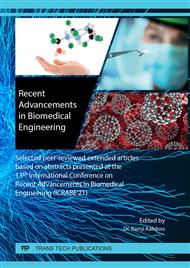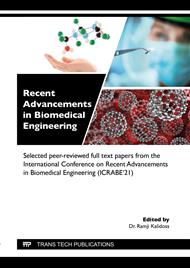[1]
A. Swami, S. Jinjun, G. Suresh, R. A. Votruba, K, Nagesh, C. O. Farokhzad. Nanoparticles for targeted and temporally controlled drug delivery. In, Svenson S, Prud'homme RK, editors. Multifunctional Nanoparticles for Drug Delivery, Applications, Imaging, Targeting, and Delivery, Nanostructure Science Technology. Bostan, USA, Springer, 2012. pp.9-25.
DOI: 10.1007/978-1-4614-2305-8_2
Google Scholar
[2]
V.J. Mohanraj, Y.Chen. Nanoparticle, A review. Trop J Pharm Res 5, (2006), 561-573.
Google Scholar
[3]
K. Sooyeon, R. K. Singh, C. Wojciech. Silica-based mesoporous nanoparticles for controlled drug delivery. J Tissue Eng 4, (2013), 1-35.
Google Scholar
[4]
L. Brannon-Peppas. Recent advances on the use of biodegradable microparticles and nanoparticles in controlled drug delivery. Int J Pharm 116, (1995), 1-9.
DOI: 10.1016/0378-5173(94)00324-x
Google Scholar
[5]
Kresge CT, Leonowicz ME, Roth WJ. Ordered mesoporous molecular sieves synthesized by a liquid-crystal template mechanism. Nature 359, (1992), 710-2.
DOI: 10.1038/359710a0
Google Scholar
[6]
Y.A. Shchipunov, Y.V. Burtseva, T. Y Karpenko, N.M. Shevchenko, T.N. Zvyagintseva, M. Starikayasss, et al. Highly efficient immobilization of endo-1, 3-beta-d-glucanases (laminarinases) from marine mollusks in novel hybrid polysaccharide-silica nanocomposites with regulated composition. J Mol Catal 40 (2006), 16-23.
DOI: 10.1016/j.molcatb.2006.02.002
Google Scholar
[7]
Y. Klichko, M. Liong, E. Choi, S. Angelos, A.E. Nel, E. Stoddart, et al. Mesostructured silica for optical functionality, nanomachines, and drug delivery. J Am Ceram Soc 92, (2009), S2-10.
DOI: 10.1111/j.1551-2916.2008.02722.x
Google Scholar
[8]
C. Tourne-Peteilh, S. Begu, D.A. Lerner, A. Galarneau, U. Lafont, J.M. Devoisselle. Sol-gel one-pot synthesis in soft conditions of mesoporous silica materials ready for drug delivery system. J Solgel Sci Technol 61, (2012), 455-462.
DOI: 10.1007/s10971-011-2646-x
Google Scholar
[9]
M. Liong, J. Lu, M. Kovochich, T. Xia, S.G. Ruehm, A.E. Nel, et al. Multifunctional inorganic nanoparticles for imaging, targeting, and drug delivery. ACS Nano 2, (2008), 889-896.
DOI: 10.1021/nn800072t
Google Scholar
[10]
C. Hongmin, Z. Zipeng, X. Jin. Label-free luminescent mesoporous silica nanoparticles for imaging and drug delivery. Theranostic 3, (2013), 650-657.
Google Scholar
[11]
J. Xie, S. Lee, X. Chen. Nanoparticle-based theranostic agents. Adv Drug Deliv Rev 62, (2012), 1064-1079.
Google Scholar
[12]
X. Lin, J. Xie, G. Niu, F. Zhang, H. Gao, M. Yang, et al. Chimeric ferritin nanocages for multiple function loading and multimodal imaging. Nano Lett 11, (2011), 814-819.
DOI: 10.1021/nl104141g
Google Scholar
[13]
C. Fruijtier-Pölloth. The toxicological mode of action and the safety of synthetic amorphous silica-a nanostructured material. Toxicology 294, (2012), 61-79.
DOI: 10.1016/j.tox.2012.02.001
Google Scholar
[14]
J.L. Vivero-Escoto, J. Luis. Surface functionalized mesoporous silica nanoparticles for intracellular drug delivery. Diss Abstr Int 71, (2009), 621-638.
DOI: 10.31274/etd-180810-1758
Google Scholar
[15]
P. Selvam, S.K. Bhatia, C.G. Sonwane. Recent advances in processing and characterization of periodic mesoporous MCM-41 silicate molecular sieves. Ind Eng Chem Res 40, (2001), 3237-3261.
DOI: 10.1021/ie0010666
Google Scholar
[16]
M. Gary-Bobo, O. Hocine, D. Brevet, M. Maynadier, L. Raehm, S. Richeter, et al. Cancer therapy improvement with mesoporous silica nanoparticles combining targeting, drug delivery and PDT. Int J Pharm 423, (2012), 509-515.
DOI: 10.1016/j.ijpharm.2011.11.045
Google Scholar
[17]
H.H. Yiu, P.A. Wright. Enzymes supported on ordered mesoporous solids, A special case of an inorganic-organic hybrid. Mater Chem 15, (2005), 3690-3700.
DOI: 10.1039/b506090g
Google Scholar
[18]
B.G. Trewyn, I.I. Slowing, S. Giri, H.T. Chen, V.S. Lin. Synthesis and functionalization of a mesoporous silica nanoparticle based on the sol-gel process and applications in controlled release. Acc Chem Res 40, (2007), 846-853.
DOI: 10.1021/ar600032u
Google Scholar
[19]
S. Radin, P. Ducheyne, T. Kamplain , B. H. Tan. Silica sol-gel for the controlled release of antibiotics. I. Synthesis, characterization, and in vitro release. J Biomed Mater Res 57, (2001), 313-320.
DOI: 10.1002/1097-4636(200111)57:2<313::aid-jbm1173>3.0.co;2-e
Google Scholar
[20]
A. Rambabu. Novel synthesis, structure and functions of mesoporous silica materials. Uppsala, Acta Universitatis Upsaliensis, 2010. pp.13-24.
Google Scholar
[21]
A. Firouzi, D. Kumar, L. M. Bull, T. Besier, P. Sieger, Q. Huo, et al.nCooperative organization of inorganic-surfactant and biomimetic assemblies. Science 267, (1995), 1138-1143.
DOI: 10.1126/science.7855591
Google Scholar
[22]
R.E. Yanes, F. Tamanoi. Development of mesoporous silica nanomaterials as a vehicle for anticancer drug delivery. Ther Deliv 3, (2012), 389-404.
DOI: 10.4155/tde.12.9
Google Scholar
[23]
J. Lu, M. Liong, J.I. Zink, F. Tamanoi. Mesoporous silica nanoparticles as a delivery system for hydrophobic anticancer drugs. Small 3, (2007), 1341-1346.
DOI: 10.1002/smll.200700005
Google Scholar
[24]
X. Huang, L. Li, T. Liu, N. Hao, H. Liu, D. Chen, et al. The shape effect of mesoporous silica nanoparticles on biodistribution, clearance, and biocompatibility in vivo. ACS Nano 5, (2011), 5390-9.
DOI: 10.1021/nn200365a
Google Scholar
[25]
Portin L. Layer by Layer Assembly of the Polyelectrolyte on Mesoporous Silicon. Biosciences, University of Eastern Finland, Finland, 2012. pp.1-59.
Google Scholar
[26]
Bergman L, Kankaanpaa L, Tiitta S, Duchanoy A, Li L, Heino J, et al. Intracellular degradation of multilabeled poly (ethyleneimine) - Mesoporous silica-silica nanoparticles, Implications for drug release. Mol Pharm 10, (2013), 1795-1803.
DOI: 10.1021/mp3005879
Google Scholar
[27]
T. Yu, A. Malugin, H. Ghandehari. Impact of silica nanoparticles design on cellular toxicity and haemolytic activity. ACS Nano 5, (2011), 5717-5728.
DOI: 10.1021/nn2013904
Google Scholar
[28]
J. Zhang, Z.F. Yuan, Y. Wang, W.H. Chen, G.F. Luo, S.X. Cheng, et al. Multifunctional envelope-type mesoporous silica nanoparticles for tumor-triggered targeting drug delivery. J Am Chem Soc 135, (2013), 5068-5073.
DOI: 10.1021/ja312004m
Google Scholar
[29]
M. Vallet-Regi, I. Izquierdo-Barba, M. Colilla. Structure and functionalization of mesoporous bioceramics for bone tissue regeneration and local drug delivery. Philos Trans R Soc A 370, (2012), 1400-1421.
DOI: 10.1098/rsta.2011.0258
Google Scholar
[30]
H. Du, P.D. Hamilton, M.A. Reilly, A. d'Avignon, P. Biswas, N. Ravi. A facile synthesis of highly water-soluble, core-shell organo-silica nanoparticles with controllable size via sol-gel process. J Colloid Interface Sci 340, (2009), 202-208.
DOI: 10.1016/j.jcis.2009.08.032
Google Scholar
[31]
S.M. Janib, A.S. Moses, J.A. MacKay. Imaging and drug delivery using theranostic nanoparticles. Adv Drug Deliv Rev 62, (2010), 1052-1063.
DOI: 10.1016/j.addr.2010.08.004
Google Scholar
[32]
L.S. Wang, L.C. Wu, S.Y. Lu, L.L. Chang, I.T. Teng, C.M. Yang. Bio functionalized phospholipid-capped mesoporous silica nanoshuttles for targeted drug delivery, Improved water suspensibility and decreased nonspecific protein binding. ACS Nano 4, (2010), 4371-4379.
DOI: 10.1021/nn901376h
Google Scholar
[33]
D. Tarn, C.E. Ashley, M. Xue, E.C. Carnes, J.I. Zink, C.J. Brinker. Mesoporous silica nanoparticle nanocarriers, Biofunctionality and biocompatibility. Acc Chem Res 46, (2013), 792-801.
DOI: 10.1021/ar3000986
Google Scholar
[34]
D. Singh, J.M. McMillan, X.M. Liu, H.M. Vishwasrao, A.V. Kabanov, M. Sokolsky-Papkov, et al. Formulation design facilitates magnetic nanoparticle delivery to diseased cells and tissues. Nanomedicine (Lond) 9, (2014), 469-485.
DOI: 10.2217/nnm.14.4
Google Scholar



